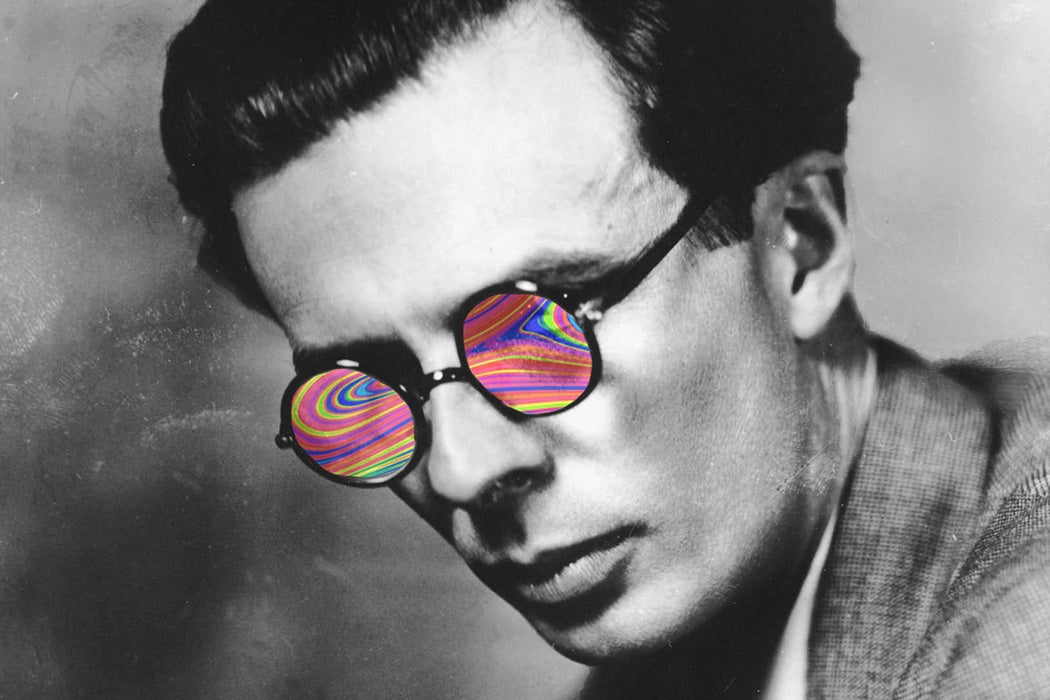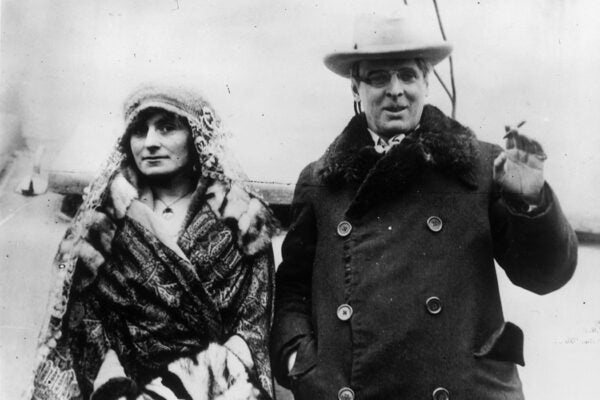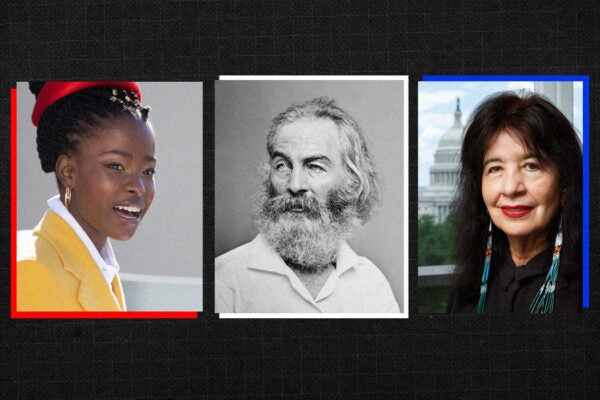Around Christmas Eve 1955, Alfred Matthew Hubbard turned Aldous Huxley on to LSD. Their meeting took place at Huxley’s home in the Hollywood Hills. Seemingly from different universes, these two figures found a curious point of convergence via lysergic acid diethylamide (LSD), the hallucinogen first synthesized in a lab in Switzerland in 1938. Humphry Osmond, a British psychiatrist who’d moved to Canada in 1951, arranged the meeting, at Huxley’s request. Osmond was by then well known as a specialist in the altered states produced by LSD and other hallucinogens. A friend of Huxley’s, Osmond had given the writer mescaline—a naturally occurring hallucinogen—in 1953; that trip inspired Huxley’s Doors of Perception from 1954, a book that details the visions the drug produced. “The seminal psychedelic handbook,” as the late Todd Brendan Fahey called it in a profile of Hubbard from High Times Magazine, records in detail Huxley’s initial chemical enlightenment.
Osmond and Huxley had discussed possible neologisms to describe the impact such drugs had on the body and mind. According to Osmond’s obituary from The BMJ,
Huxley suggested “phanerothyme,” from the Greek words for “to show” and “spirit,” and sent a rhyme: “To make this mundane world sublime, Take half a gram of phanerothyme.” Instead, Osmond chose “psychedelic,” from the Greek words psyche (for mind or soul) and deloun (for show), and suggested, “To fathom Hell or soar angelic/Just take a pinch of psychedelic.”
Huxley then used the phrase “Heaven and Hell” as the title of a book exploring the mind’s capacity to produce extraordinary visionary experiences, though it’s unclear how much he was inspired by Osmond’s witticism and how much by William Blake’s The Marriage of Heaven and Hell.
Weekly Newsletter
Seven years apart in age, Hubbard and Huxley made an unlikely pair. The Kentucky-born Hubbard, the younger of the two, reportedly had a checkered past that included dubious inventions, arms dealing, and a conviction for smuggling booze from Mexico to California—a trade that may have helped him forge connections that later proved useful in distributing LSD. Known variously as the “Johnny Appleseed of LSD” and “the Captain,” Hubbard earned a Master of Sea Vessels certification in California after serving a prison term for the aforementioned conviction. By 1955, he had relocated to Canada, likely to escape additional criminal charges in the US. There, according to Fahey’s 1991 account, he sought out Osmond and took him to lunch. In his later years, he showed up at gatherings sporting a buzzcut, clad in paramilitary fatigues, and brandishing a long-barreled pistol.
“Fueled by psychedelics,” wrote Fahey, “he set sail and rode the great wave as a neuronaut, with only the white noise in his ears and a fever in his brain.”
Huxley, by contrast, was an English intellectual who towered over Hubbard. He came from an illustrious family and studied at Eton and Oxford; Thomas Henry Huxley, his grandfather, was a biologist nicknamed “Darwin’s bulldog” for his formidable promotion of evolutionary theory. On the other hand, Hubbard was born into poverty and failed to make it to high school. Huxley had relocated to Los Angeles in 1937 to write screenplays (among them was the 1940 adaptation of Pride and Prejudice starring Laurence Olivier and Greer Garson), though he’s better known for his forty-eight works of fiction and non-fiction including the dystopian classic Brave New World, published in 1932. In the 1962 utopian novel Island, his last book, LSD plays a key role as a medication.
In spite of their differences, the two men found common cause that early winter’s night with the help of LSD. As was his fashion, Hubbard emphasized the value of set and setting while dropping acid. He played recordings of classical music and decorated studio walls with art to help focus imaginations. Huxley was won over by the experience. He approached the drug with the curiosity of an intellectual and the calculation of a scholar. He referred in a letter to “a remarkable personage called Captain Hubbard–a millionaire businessman–physicist, scientific director of the Uranium Corporation, who took mescalin[e] last year, was completely bowled over by it and is now drumming up support among his influential friends.” He admired Hubbard both as a therapist and as “a very nice man,” wrote journalist Michael Pollan in How to Change Your Mind; according to historian Brad Holden, Huxley considered Hubbard “a terrific man of action, and results of his efforts may begin appearing quite soon.”
The relationship between Hubbard and Huxley sheds light on the transformative power of a single encounter and the ongoing exploration of consciousness. A man who thrived on the fringes, Hubbard was an enthusiastic pioneer. He was said to be the first person to import LSD to North America in the early 1950s, before Timothy Leary made it fashionable, and was at one point the only legal importer of the drug to Canada; he bought it legally from Sandoz, the lab in Switzerland, where it was manufactured, and sold it to individual users as well as psychiatrists who went on to give it to Cary Grant, Jack Nicholson, and Stanley Kubrick, among others. Indeed, Hubbard gained legal sanction in Canada to distribute LSD for curative purposes before most psychiatrists themselves had gotten certified. He had finally hit his stride after years spent as a smuggler, then, ironically, as a Prohibition agent hired by the government to arrest smugglers. He embraced LSD with a convert’s zeal, keen to share its epiphanic potential. But his interests weren’t entirely selfless. As Fahey reports, one Canadian businessman, after coming down from the acid session that Hubbard provided, told Hubbard he didn’t need “to worry about money again: He had seen the future, and Al Hubbard was its Acid Messiah.”
Even before the LSD, Hubbard found a way to cash in. He smuggled ships and weaponry to Canada during the Second World War, while the US was still neutral, and he established the Radium Chemical Company in Vancouver. Some accounts suggest Hubbard also helped build atom bombs for the US. Perhaps profits from these wartime activities paid for Dayman Island, the twenty-four-acre landmass near British Columbia that he and his wife bought in 1949, where they kept an airplane, a yacht, and a hangar. Whatever his muddled financial history, after LSD was outlawed in 1968, Hubbard lost his assets and died in a trailer park in Casa Grande, Arizona, in 1982.
On Huxley’s part, his 1955 acid trip with Hubbard marked a turning point. As Michael Pollan phrases it, “The experience put the author’s 1953 mescaline trip in the shade.” Hubbard unlocked a door in Huxley’s perception that would never close, and his later trips informed his writing profoundly. The insights he gained reached across the subjects of religion, geography, and art history. His books still provide a framework for others who champion psychedelic tripping as a form of therapy.
In his writings, Huxley never mentions Hubbard’s criminal past. Maybe he didn’t know about it, or that Hubbard was a political conservative who worked as a government operative in a precursor organization to the CIA. Indeed, Huxley never names Hubbard in any of his books, only in his correspondence; as for Osmond, he’s identified only as “the investigator” in The Doors of Perception.
Huxley died less than eight years after he met Hubbard, coincidentally on the same day that President John F. Kennedy was assassinated, November 22, 1963. Huxley’s wife Laura, born in Italy, had trained as a classical musician and—fittingly—as a psychotherapist. They married in 1956. (Huxley’s previous wife, Maria Nys, died of cancer in 1955.) In a lengthy and eloquent letter, Laura set down her husband’s final hours. Dated December 8, 1963, the letter addressed Julian and Juliette Huxley, his brother and sister-in-law.
LSD had become a family affair. Laura took it with Aldous, and she learned how to inject him with painkillers when he grew ill. In her tender and eloquent missive, she expressed concern that history would come to regard her husband as an addict, even though LSD had yet to accumulate the stigma that was soon to get it banned throughout North America. In Huxley’s final hours, Laura asked if he would like her to join him on his final LSD trip. He said yes. While it’s unclear if she did indeed partake, her letter makes plain that she injected her husband with LSD twice, the first time with an intramuscular “shot of 100 microgrammes.” Aldous, she wrote, considered LSD to be the “moksha medicine in which he believed,” referencing the Sanskrit term for “enlightenment” or “liberation.”
“Moksha-medicine” appears twenty-two times in Huxley’s Island: A Novel, which tells of an ideal society in the Pacific where drug use and free sex are encouraged. The resulting harmony and bliss draw the envy and hostility of the surrounding world. Moksha, a central concept in several South Asian religions, refers to end-of-life freedom from saṃsāra, the cycle of death and rebirth. Moksha can also represent a condition of bliss, a union with the divine, or a state of perfect peace and liberation from suffering. Island is a utopian response to Brave New World, published in 1932, and to Joseph Conrad’s Heart of Darkness published about three decades earlier.
By turning Huxley on to LSD, Hubbard not only influenced his literary output but also helped free him from the pain and anxiety that accompanied the laryngeal cancer that did him in. Laura’s words capture the quality of their final, acid-saturated hours together:
“Easy, easy, and you are doing this willingly and consciously and beautifully—going forward and up, light and free, forward and up toward the light, into the light, into complete love.”
The chemical substance LSD became a tool for both men to advance their respective interests. For Hubbard it was a map to financial gain and a key to mental health; for Huxley it was a lens to explore the intricate complexities of consciousness. Their relationship may have been brief, but its significance transcends Osmond’s introduction of the two men. Hubbard, the unorthodox guide, provided the LSD. Huxley, the luminary and artist, embarked on a journey that left a lasting mark on philosophy, literature, and our understanding of the human mind.







